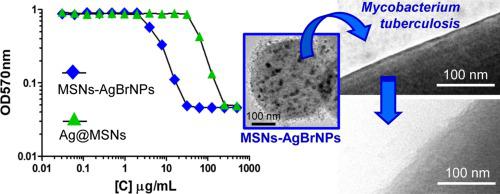Colloids and Surfaces B: Biointerfaces ( IF 5.4 ) Pub Date : 2020-10-25 , DOI: 10.1016/j.colsurfb.2020.111405 Sandra Montalvo-Quirós 1 , Sergio Gómez-Graña 2 , María Vallet-Regí 3 , Rafael C Prados-Rosales 4 , Blanca González 3 , Jose L Luque-Garcia 5

|
Tuberculosis remains today a major public health issue with a total of 9 million new cases and 2 million deaths annually. The lack of an effective vaccine and the increasing emergence of new strains of Mycobacterium tuberculosis (Mtb) highly resistant to antibiotics, anticipate a complicated scenario in the near future. The use of nanoparticles features as an alternative to antibiotics in tackling this problem due to their potential effectiveness in resistant bacterial strains. In this context, silver nanoparticles have demonstrated high bactericidal efficacy, although their use is limited by their relatively high toxicity, which calls for the design of nanocarriers that allow silver based nanoparticles to be safely delivered to the target cells or tissues. In this work mesoporous silica nanoparticles are used as carriers of silver based nanoparticles as antimycobacterial agent against Mtb. Two different synthetic approaches have been used to afford, on the one hand, a 2D hexagonal mesoporous silica nanosystem which contains silver bromide nanoparticles distributed all through the silica network and, on the other hand, a core@shell nanosystem with metallic silver nanoparticles as core and mesoporous silica shell in a radial mesoporous rearrangement. Both materials have demonstrated good antimycobacterial capacity in in vitro test using Mtb, being lower the minimum inhibitory concentration for the nanosystem which contains silver bromide. Therefore, the interaction of this material with the mycobacterial cell has been studied by cryo-electron microscopy, establishing a direct connection between the antimycobactericidal effect observed and the damage induced in the cell envelope.
中文翻译:

含银的新型介孔二氧化硅纳米颗粒作为抗结核分枝杆菌的抗细菌剂
今天,结核病仍然是主要的公共卫生问题,每年共有900万新病例和200万死亡。缺乏有效的疫苗,结核分枝杆菌(Mtb)新菌株的出现越来越多)对抗生素高度耐药,因此在不久的将来会遇到复杂的情况。由于纳米粒子在抗药性菌株中具有潜在的功效,因此使用纳米粒子作为抗生素的替代品可解决该问题。在这种情况下,尽管银纳米颗粒的使用受到其相对较高的毒性的限制,但已显示出高杀菌功效,这要求设计纳米载体,以使基于银的纳米颗粒安全地递送至靶细胞或组织。在这项工作中,介孔二氧化硅纳米粒子被用作银基纳米粒子的载体,作为针对Mtb的抗分枝杆菌剂。一方面,已经使用两种不同的合成方法来提供二维六方介孔二氧化硅纳米系统,该系统包含遍布整个二氧化硅网络分布的溴化银纳米颗粒,另一方面,以金属银纳米颗粒为核的核壳纳米系统和介孔二氧化硅壳呈放射状介孔重排。两种材料在使用Mtb的体外测试中均显示出良好的抗分枝杆菌能力降低了含有溴化银的纳米系统的最小抑制浓度。因此,已经通过冷冻电子显微镜研究了这种材料与分枝杆菌细胞的相互作用,在观察到的抗分枝杆菌作用与细胞包膜中引起的损伤之间建立了直接联系。











































 京公网安备 11010802027423号
京公网安备 11010802027423号